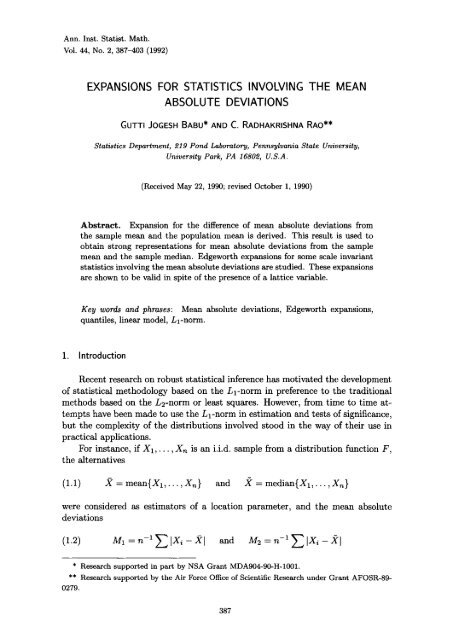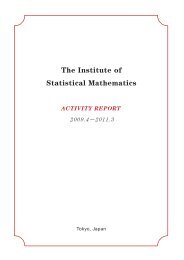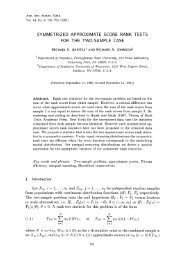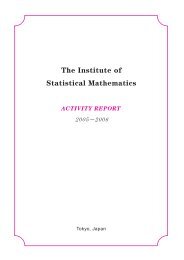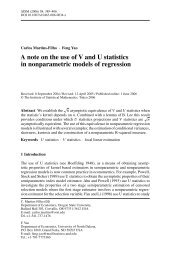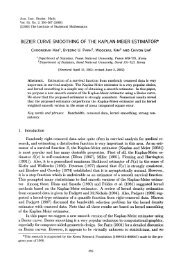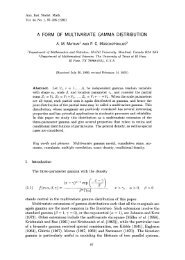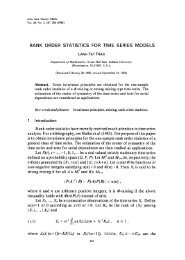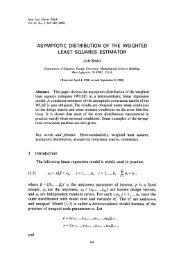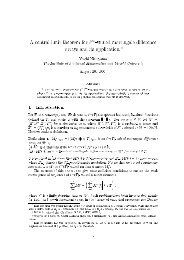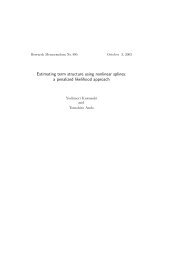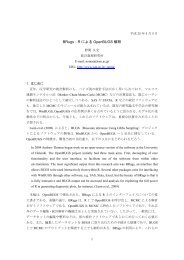Expansions for statistics involving the mean absolute deviations
Expansions for statistics involving the mean absolute deviations
Expansions for statistics involving the mean absolute deviations
Create successful ePaper yourself
Turn your PDF publications into a flip-book with our unique Google optimized e-Paper software.
Ann. Inst. Statist. Math.<br />
Vol. 44, No. 2, 387-403 (1992)<br />
EXPANSIONS FOR STATISTICS INVOLVING THE MEAN<br />
ABSOLUTE DEVIATIONS<br />
GUTTI JOGESH BABU* AND C. RADHAKRISHNA RAO**<br />
Statistics Department, 219 Pond Laboratory, Pennsylvania State University,<br />
University Park, PA 16802, U.S.A.<br />
(Received May 22, 1990; revised October 1, 1990)<br />
Abstract. Expansion <strong>for</strong> <strong>the</strong> difference of <strong>mean</strong> <strong>absolute</strong> <strong>deviations</strong> from<br />
<strong>the</strong> sample <strong>mean</strong> and <strong>the</strong> population <strong>mean</strong> is derived. This result is used to<br />
obtain strong representations <strong>for</strong> <strong>mean</strong> <strong>absolute</strong> <strong>deviations</strong> from <strong>the</strong> sample<br />
<strong>mean</strong> and <strong>the</strong> sample median. Edgeworth expansions <strong>for</strong> some scale invariant<br />
<strong>statistics</strong> <strong>involving</strong> <strong>the</strong> <strong>mean</strong> <strong>absolute</strong> <strong>deviations</strong> are studied. These expansions<br />
are shown to be valid in spite of <strong>the</strong> presence of a lattice variable.<br />
Key words and phrases: Mean <strong>absolute</strong> <strong>deviations</strong>, Edgeworth expansions,<br />
quantiles, linear model, Ll-norm.<br />
1. Introduction<br />
Recent research on robust statistical inference has motivated <strong>the</strong> development<br />
of statistical methodology based on <strong>the</strong> Ll-norm in preference to <strong>the</strong> traditional<br />
methods based on <strong>the</strong> L2-norm or least squares. However, from time to time attempts<br />
have been made to use <strong>the</strong> Ll-norm in estimation and tests of significance,<br />
but <strong>the</strong> complexity of <strong>the</strong> distributions involved stood in <strong>the</strong> way of <strong>the</strong>ir use in<br />
practical applications.<br />
For instance, if X1,..., Xn is an i.i.d, sample from a distribution function F,<br />
<strong>the</strong> alternatives<br />
(1.1) 2 = <strong>mean</strong>{X1,..., Xn} and )( = median{X1,..., Xn}<br />
were considered as estimators of a location parameter, and <strong>the</strong> <strong>mean</strong> <strong>absolute</strong><br />
<strong>deviations</strong><br />
(1.2) M1 = n-1 E IXi - )fl and M2 = n -1 E IXi - X]<br />
* Research supported in part by NSA Grant MDA904-90-H-1001.<br />
** Research supported by <strong>the</strong> Air Force Office of Scientific Research under Grant AFOSR-89-<br />
0279.<br />
387
388 GUTTI JOGESH BABU AND C. RADHAKRISHNA RAO<br />
were considered as estimates of a scale parameter as alternatives to <strong>the</strong> root <strong>mean</strong><br />
square deviation<br />
(1.3)<br />
Godwin (1943) found <strong>the</strong> distribution of M1 when F is normal, but <strong>the</strong> expression<br />
<strong>for</strong> <strong>the</strong> density turned out to be very complicated. Geary (1936) considered one<br />
of <strong>the</strong> following <strong>statistics</strong> (W1)<br />
M1<br />
(1.4) W1 = , W2 =<br />
8 8<br />
as a test of <strong>the</strong> normality of F. In fact, he obtained <strong>the</strong> Edgeworth expansion of<br />
<strong>the</strong> distribution of W1 when F is normal. Herrey (1965) discussed <strong>the</strong> use of one<br />
of <strong>the</strong> following <strong>statistics</strong> (tl)<br />
M2<br />
v (2 - It) v (2 - It)<br />
(1.5) tl -- and t2 -<br />
M1<br />
M2<br />
to obtain a confidence interval <strong>for</strong> <strong>the</strong> unknown <strong>mean</strong> It of <strong>the</strong> population when F<br />
is normal. His analysis rests on <strong>the</strong> fact that )( - # and M1 are independent <strong>for</strong><br />
samples from a normal distribution. Two o<strong>the</strong>r possibilities <strong>for</strong> this purpose are<br />
v (R - It) v (k - p)<br />
(1.6) t3 - and t4 -<br />
M~ M2<br />
In this paper, we derive <strong>the</strong> asymptotic representations of <strong>the</strong> <strong>statistics</strong><br />
(1.7) M1, M2; W1, W2; tl, t2<br />
<strong>for</strong> a general d.f. F, and obtain Edgeworth expansions under some moment conditions.<br />
We also consider <strong>the</strong> Gauss-Markov linear model, define <strong>statistics</strong> of <strong>the</strong> <strong>for</strong>m<br />
(1.7) depending on L1 and L2-norms, and study <strong>the</strong>ir asymptotic distributions.<br />
We use <strong>the</strong> elementary integral representation<br />
~0<br />
1<br />
(1.8) Ixl - ]x - a] = a sign(x - ya)dy<br />
to express <strong>the</strong> <strong>statistics</strong> (1.7) as a sum of i.i.d, random variables plus quadratic<br />
term plus a remainder which is negligible in large samples. The recent work of<br />
Babu and Singh (1989) is used to obtain <strong>the</strong> Edgeworth expansions.
EXPANSIONS FOR ABSOLUTE DEVIATIONS 389<br />
2. Asymptotics of <strong>the</strong> <strong>mean</strong> <strong>absolute</strong> <strong>deviations</strong><br />
Let X1,..., Xn be i.i.d, random variables with a common d.f. F such that<br />
(2.1) E(X1) : ~, Y(Xl) ~- (72 < (Do<br />
and define <strong>the</strong> <strong>statistics</strong> (<strong>mean</strong> <strong>absolute</strong> <strong>deviations</strong>)<br />
(2.2) M1 = n -1 IX~ - 21, M2 ---- n -1 ~ IX, - 21<br />
1 1<br />
where .K and )~ are <strong>the</strong> sample <strong>mean</strong> and median respectively. In this section, we<br />
obtain representations of M1 and M2 to derive <strong>the</strong>ir asymptotic distributions and<br />
<strong>for</strong> later use in Section 3 in getting <strong>the</strong> Edgeworth expansions of <strong>the</strong> distributions<br />
of certain <strong>statistics</strong>. We denote<br />
(2.3) M~ = n -1 ~ IX~ - ~1, M~ = n -1 y~ IX, - "1<br />
1 1<br />
where # and v are <strong>the</strong> population <strong>mean</strong> and median respectively. Let Fn denote<br />
<strong>the</strong> empirical distribution function<br />
(2.4) F,(x) = 7t -1 E I(Xi 1 and 0 < fl
390<br />
GUTTI JOGESH BABU AND C. RADHAKRISHNA RAO<br />
where<br />
(2.8)<br />
1<br />
R~ = 2 fo [F,~(it + (2 - It)y) - Fn(it) - F(it + (X - It)y) + F(#)]dy.<br />
By taking an as in Lemma A.2 to be n -1/2 logn, we get (2.7). This completes <strong>the</strong><br />
proof.<br />
THEOREM 2.2. If F is differentiable in a neighborhood of It and <strong>the</strong> derivative<br />
f at It is positive, <strong>the</strong>n with probability 1,<br />
(2.9) M1 - M I = (X - It)(2Fn (#) - 1) + (2 - It)2 (f(it) + o(1)) + O(n -5/a (log n)2).<br />
PROOF. By Lemma A.4, we have with probability 1<br />
(2.10) n~/~lx - ul 1 and 0 < fl < 1, F satisfies <strong>the</strong><br />
(2.11) IF(x) - F(I~)I _< clx - Itl ~.<br />
Then<br />
(2.12) v~[M1 - M~ - (2F(it) - 1)(){ -/~)] P~ 0.<br />
Consequently<br />
(2.13) v/-n(M1 - (2F(it) - 1)(X - It) - EIX1 - Itl) ~ Y(0, a~),<br />
wher{~<br />
a~ = V(lXl - It[ + (2F(it) - 1)(X, - It))<br />
= (2F(it) - 1)2V(X1) + (4F(#) - 2)cov(lX1 - ItI,X1 - It) + V(IX1 - Itl).<br />
In particular, if F(#) = 1/2, i.e., <strong>the</strong> population <strong>mean</strong> and median coincide, <strong>the</strong>n<br />
(2.14) v~(M1 - EIX~ - Itl) 9, U(0, V(]X1 - #l)).
EXPANSIONS FOR ABSOLUTE DEVIATIONS 391<br />
PROOF. Since v/-~]X - #] is bounded in probability and Fn(#) P~ F(#),<br />
(2.12) follows from Theorem 2.1, from which (2.13) follows.<br />
THEOREM 2.4. Let F be differentiable in a neighborhood of# and <strong>the</strong> derivative<br />
f at # be positive. We have:<br />
(i) /y F(~) # 1/2, <strong>the</strong>n<br />
V/-~[2F(, ) _ 1]_1(M1 _ MI ) 9<br />
g(0, V(Xl)).<br />
(ii) IRE(#) = 1/2, <strong>the</strong>n<br />
n(il-U;) v f(#)U 2_UV,<br />
where (U, V) is a bivariate normal variable with <strong>mean</strong> zero and covariance matrix<br />
[ y(x1) ElXi- f]<br />
-= L EIX1 - #[ 1 "<br />
PROOF. The results of Theorem 2.4 follow from <strong>the</strong> representation (2.9) of<br />
Theorem 2.2, and (2.12) of Theorem 2.3, which imply that<br />
and<br />
v/-n[M1-M~-(X-#)(2F(p)-I)] e 0, if F(#)~1/2<br />
n[(M1 - M~) - (X" - #)2f(#) _ (.e~ - #)(2Fn(#) - 1)] P, 0,<br />
if F(#) = 1/2.<br />
THEOREM 2.5.<br />
Let F have a unique median t~ and satisfy <strong>the</strong> condition<br />
IF(x) - F(t/)l < clx - t/I s<br />
<strong>for</strong> some c > 1 and 0 <
392<br />
GUTTI JOGESH BABU AND C. RADHAKRISHNA RAO<br />
Since<br />
we have<br />
sup<br />
0
-<br />
EXPANSIONS FOR ABSOLUTE DEVIATIONS 393<br />
3. Edgeworth expansions <strong>for</strong> some scale invariant <strong>statistics</strong><br />
In this section we obtain <strong>the</strong> Edgeworth expansions <strong>for</strong> <strong>the</strong> distributions of<br />
<strong>the</strong> scale invariant <strong>statistics</strong><br />
M1<br />
Ms<br />
(3.1) w1- , w2=<br />
s 8<br />
v~(X - ~) v~(:~ - ~)<br />
(3.2) tl -- , t2 -<br />
Mi<br />
M2<br />
using <strong>the</strong> asymptotic representations of M1 and 21//2 derived in Section 2. It turns<br />
out that <strong>the</strong> main terms in <strong>the</strong> asymptotic expansions of <strong>the</strong>se <strong>statistics</strong> involve lattice<br />
as well as non-lattice random variables and <strong>the</strong> standard results on Edgeworth<br />
expansions of <strong>the</strong>ir distributions are not applicable. However, <strong>the</strong> lattice variables<br />
appear only in <strong>the</strong> quadratic term <strong>for</strong> W1 and W2, in which case <strong>the</strong> recent results<br />
of Babu and Singh (1989) enable <strong>the</strong> evaluation of two-term Edgeworth expansion<br />
<strong>for</strong> W1 and W2. By using a generalization (see Babu (1991)) of <strong>the</strong> results of Babu<br />
and Singh (1989), we develop three term Edgeworth expansions <strong>for</strong> ti, i = 1, 2.<br />
The following notations are used<br />
V(Xl) = E(X1 - #)2 _~ o.2,<br />
Y~ = (Xi - ~)/0., ~1 -- EIYll,<br />
Z, -- IXi - ~1/0., ~ = E(ZI),<br />
1~ _- n-1 ~ Y/,<br />
2 = n -1 ~Zi.<br />
We now state and prove <strong>the</strong> main <strong>the</strong>orems.<br />
THEOREM 3.1.<br />
of # and f(#) > O.<br />
neighborhood of #.<br />
Suppose that F has a continuous density f in a neighborhood<br />
For some c > 0 and/3 > O, let I](#) - f(x)l < cl x- #1 ~ in a<br />
If E(X61) < oc, <strong>the</strong>n we have<br />
(3.3)<br />
1 3<br />
:1 - y2 IYI - "},'1 ~-- ~-9'1(1 - y~)2 + R.1<br />
W1 - ~1 = L - Y H + 2<br />
where <strong>the</strong> notation ~t is used <strong>for</strong> <strong>the</strong> average oral,..., an,<br />
L/= IY/I - ~'1(1 + Y/2),<br />
Hi=signYi-[0.f(#)+~'yl]Yi,<br />
and<br />
P(IR.I] > an -1-~) = o(n -1/2)<br />
]:or some tc > 0 and e > O.<br />
PROOF.<br />
The <strong>the</strong>orem follows from Theorem 2.2 and <strong>the</strong> observation that<br />
a_s 1---- -~(1-(s/0.) 2)+-83(1<br />
- (sl0.)2) ~ + O((1 - (s/0.)2) 3)
9'2)<br />
394 GUTTI JOGESH BABU AND C, RADHAKRISHNA RAO<br />
and <strong>the</strong> moderate deviation result of Michel (1976) that <strong>for</strong> some A<br />
(3.4) P(v~IX - #l > Alogn) = o(n-1).<br />
(In fact Michel (1976) shows that (3.4) holds under <strong>the</strong> condition E(X~) < oo.)<br />
THEOREM 3.2. Suppose that F has a continuous density f in <strong>the</strong> neighborhood<br />
of v and f(u) > O. For some c > 0 and ~ > O, let If(u) - f(x)] < clx- v] ~<br />
in a neighborhood of v. I~ E(x~) < cx~, <strong>the</strong>n we have<br />
1<br />
(3.5) W2 - 9'2 = b - (1/4af(v))(1 - 2Fn(v)) 2 + ~Z - 9'2 1 - y2<br />
where<br />
1 1<br />
ni = Zi - ~9"2( + y2)<br />
<strong>for</strong> some ~ > O and e > O.<br />
and<br />
P(IRn21 > an -1-¢) = o(n -U2)<br />
Proof of this <strong>the</strong>orem is similar to that of Theorem 3.1, and so is omitted.<br />
Note that if u = p, <strong>the</strong>n Z~ = tYil and 9'1 = 9'2 and hence D~ = Li. Fur<strong>the</strong>r,<br />
in both <strong>the</strong> representations (3.3) and (3.5) <strong>the</strong> lattice variables appear only in <strong>the</strong><br />
quadratic term. So <strong>the</strong> results of Babu and Singh (1989) which generalize some of<br />
<strong>the</strong> results of Bhattacharya and Ghosh (1978), apply and both W1 and W2 have<br />
valid two-term Edgeworth expansions. The next <strong>the</strong>orem gives <strong>the</strong>se expansions.<br />
x<br />
THEOREM 3.3.<br />
Under <strong>the</strong> conditions of Theorem 3.1, we have uni<strong>for</strong>mly in<br />
1<br />
(3.6) P(v~(W1 - 9'1) _< x) ---- (bu~ (x) + -~pl(x)~n~(x ) + o(n-1/2).<br />
Under <strong>the</strong> conditions of Theorem 3.2, we have uni<strong>for</strong>mly in x<br />
(3.7) P(v~(W2 -<br />
In (3.6) and (3.7),<br />
1<br />
_< x) ---- ~,~(x) + -~p2(x)~pn~(x) + o(n-1/2).<br />
~ = E(L~) = 1 + ~9"1 [E(Xi - .)~o-~ - 11 - ~EIXi - .I~o -~,<br />
1 E<br />
rl~ = E(D~) = E(Xa - v)2~ -2 + ~9"2[ (X~ - v)% -4 - 11<br />
- 9"2E[(X1 - .)21X1 - vl~-3],<br />
1 1 x 2 2<br />
pl(x) = ~ + ~13( - (/,~)),<br />
1<br />
p2(x) = ~2 + ~23(1 - (~/~)),
- 1)(Xi<br />
t),<br />
EXPANSIONS FOR ABSOLUTE DEVIATIONS 395<br />
where<br />
=1 5-<br />
~ ~1[ 3~-~E(X1 - t) ~] ~f(t) + ~-~EIX~ - tl ~,<br />
/g2 -- 4f(t/) ~"/2 -}- E[(Xl - t)21Xl -/]lff-3],<br />
7112/~13 --- E(L 3) - 6E(LIY1)E(LIHI) - 3E(L11Y1 IS(LaY}))<br />
+ ~I(E(L1Y})) 2,<br />
~3 = E(D 3) 3 2f(v) E[D1 sign(X1 - v)] 2 - 3E(DIZ1)E(D1Y 2)<br />
+ 3(E(DIY1)) 2 + ~?2(E(DzY})) 2.<br />
Remark 2.<br />
If F is symmetric, <strong>the</strong>n<br />
T]12~13 ---- 7122~;23 ~--- E(L 3) - 3E(IY 11L1)E(y2L1) + 9~fl (E(LIY})) 2.<br />
Remark 3. ~/1 = E(IX - t]/a) is known <strong>for</strong> some parametric families. For<br />
example in Gaussian case, V1 = v/2v/~- The order of error in (3.6) does not change<br />
if <strong>the</strong> coefficients of <strong>the</strong> polynomial Pl are replaced by <strong>the</strong>ir sample estimates.<br />
In view of <strong>the</strong> unknown parameter 711 , (3.6) may not be of much help in<br />
practice. However, such expansions are essential, in establishing superiority of <strong>the</strong><br />
bootstrap estimate. By some additional algebra, it is possible to show, as in Liu<br />
and Singh (1987), that <strong>the</strong> bootstrap distribution of v/~(W1 - "Y1) gives a better<br />
approximation to its sampling distribution than (I)v~., (x), in terms of asymptotic<br />
<strong>mean</strong> squared error, where 712,n is an estimator of 7112. Similar comments apply<br />
throughout this section.<br />
We now consider representations and three-term Edgeworth expansions <strong>for</strong> tl<br />
and t2 defined in (3.2).<br />
From Theorem 2.1 and (3.4) we have <strong>the</strong> following representations.<br />
THEOREM 3.4. Suppose that F has a continuous density f in a neighborhood<br />
oft and f(t) > O. For some c > 0 and/3 > O, let If(t) - f(x)l < clx- tl f~ in a<br />
neighborhood of t. If E(X¢) < oc, <strong>the</strong>n<br />
(3.s)<br />
where<br />
and<br />
tl ---- V/-~(X -- t)(1 - U + V(X - t)o "-z + 0 2) + Rn3<br />
"/1Cr<br />
~lUi = Ix~ - tl - ~/1 n t- (2F(t) -<br />
-<br />
"}'IV/ = 2F(t) - 2I(Xi
396 GUTTI JOGESH BABU AND C. RADHAKRISHNA RAO<br />
<strong>for</strong> some ~ > O and e > O.<br />
P(IP~a[ > t~n -l-e) = o(n -1)<br />
THEOREM 3.5.<br />
Under <strong>the</strong> conditions of Theorem 3.4, if tt = u, <strong>the</strong>n<br />
(3.9) t2 = v~ ()~- .)(1-U" +/)2 + (1- 2F"(u))2)<br />
710. 4~ 1-~-~ -~- Rn4<br />
where P(IRnn[ > ~n -1-~) : o(n -1) <strong>for</strong> some tz > 0 and e > O.<br />
The results of Babu and $ingh (1989) do not give a valid three-term Edgeworth<br />
expansion <strong>for</strong> tl and t2. However, a refinement of it due to Babu (1991) provides<br />
<strong>the</strong> desired expansion.<br />
THEOREM 3.6.<br />
Under <strong>the</strong> conditions of Theorem 3.4, we have<br />
(3.10)<br />
P(tl
EXPANSIONS FOR ABSOLUTE DEVIATIONS 397<br />
Remark 5. ~/1 here is <strong>the</strong> shape parameter which is known <strong>for</strong> some parametric<br />
families. The coefficients of <strong>the</strong> polynomials/92, /O21 and P22 can be replaced<br />
by <strong>the</strong>ir estimates without changing <strong>the</strong> magnitude of <strong>the</strong> error. For symmetric<br />
populations P1 -- 0. So<br />
^<br />
P(tl _< x) = (I).yl_2(x) + ~l---~n (P2(~lx) + D2i(~lX))~/1--2(X ) -~- o(n-1),<br />
where ^'s signal that <strong>the</strong> quantities are estimated. In <strong>the</strong> Gaussian case ~/1 =<br />
~1 ~-- t~3 ---~ 0~<br />
v/2/7r,<br />
a2 = (3r/2) - 1 - vf~ and a4 = -12 + 6v/~.<br />
Some of <strong>the</strong> results on Edgeworth expansions may be derived using Bai and<br />
aao (1991), instead of Babu and Singh (1989) and Babu (1991). However, it<br />
should be noted that, in our case, it is not trivial to verify Assumption 4 of Bai<br />
and Rao (1991).<br />
4. Statistics associated with linear models<br />
In this section, we consider <strong>the</strong> Gauss-Markov linear model, define <strong>statistics</strong><br />
similar to those introduced in Sections 2 and 3 and discuss <strong>the</strong>ir asymptotic distributions.<br />
To avoid complicated notation, we consider a simple model. Let<br />
(4.1) Yi = xi~/~+ei, i = 1,...,n,<br />
where ~i,..., en are i.i.d, random variables, xi~ are m-dimensional row vectors<br />
such that ~ x~nXin = I and <strong>the</strong> true value of fl is zero without loss of generality.<br />
We make <strong>the</strong> following assumptions<br />
(A1) The common d.f. F of ei has median zero, has a derivative f in <strong>the</strong><br />
neighborhood of zero and <strong>for</strong> some c > 0<br />
1<br />
(4.2) f(0) > 0, F(0) -- and If(y)- f(O)l _ clyl 1/2<br />
(A2)<br />
(4.3) qn(logn) 1/2 -~ 0 as n --~ oc,<br />
where q~ = max{llxinll : 1 < i < n}. Clearly nq 2 > m using <strong>the</strong> condition<br />
E' XinXin ~ I.<br />
We denote <strong>the</strong> least <strong>absolute</strong> <strong>deviations</strong> (LAD) and least square (LS) estimates<br />
of f~ by/~ and/~ respectively.<br />
Using <strong>the</strong> results of Babu (1989), <strong>the</strong> following <strong>the</strong>orem can be established.<br />
THEOREM 4.1.<br />
Under <strong>the</strong> assumptions (A1) and (A2) we have:
398 GUTTI JOGESH BABU AND C. RADI-IAKRISHNA RAO<br />
(i) For some B > O,<br />
(4.4) P(IIDIt > B(logn) 1/2) = O(n-2) •<br />
(ii)<br />
(4.5) 2f(0)~ = Z x~n sign Yi + Rnl<br />
1<br />
where <strong>for</strong> some c > 0, P(IRnl[ > cqln/2(logn)3/4) = O(n-2).<br />
(iii)<br />
(4.6) n<br />
4f(O)<br />
]~1 signyi 2<br />
x,n -4- R~2<br />
i=1<br />
1/5 5/4<br />
where <strong>for</strong> some c > O, P([/~2[ > Cqn (logn) ) = O(n-2).<br />
(iv) Using Borel-Cantelli Lemma, it follows that <strong>the</strong> errors P~i<br />
(4.5) and (4.6) satisfy with probability 1<br />
and t~2 in<br />
(4.7)<br />
Rnl = O(ql/2(logn) 3/4) and Rn2 = O(qln/2(logn)5/4).<br />
THEOREM 4.2. Under <strong>the</strong> assumptions (Aa) and (A2) and <strong>the</strong> additional assumption<br />
on <strong>the</strong> LS estimation<br />
(4.8) P(ll¢)ll > A(logn) U2) = o(n -i/2) or o(n -i)<br />
we have<br />
n n n<br />
(4.9) E ly~ - xin~l = ~ lyil + f(o)ll~ll ~ + 2 ~ x,n[/(y~ < o) - F(ol]~ + P~<br />
1 1 1<br />
where <strong>for</strong> some B > 0<br />
(4.10) P(IRnl > Bq~/2(logn) 5/4) = o(n -1/2)<br />
or<br />
o(n-1).<br />
If <strong>the</strong> stronger condition<br />
(4.1i)<br />
~ ----<br />
O((logn) i/2)<br />
with probability 1,<br />
holds <strong>for</strong> <strong>the</strong> LS estimator ~, <strong>the</strong>n<br />
(4.12) /~ = O(qln/2(log n) 5/4)<br />
with probability 1.
EXPANSIONS FOR ABSOLUTE DEVIATIONS 399<br />
Remark 6. If E(ei) = O, E(e~) < oo and q~ = O(n-1/a(logn) -1) <strong>the</strong>n by<br />
Lemma A.5 of <strong>the</strong> Appendix, (4.8) holds with o(n-U2). By similar arguments, it<br />
can be shown that (4.8) holds with o(n-:) if in addition E(e 6) < exp.<br />
In summary we have <strong>the</strong> representations:<br />
(4.13) 2f(0)~ = fix~n signyi + Rnl,<br />
?Z<br />
(4.14) ~ = E x~inYi'<br />
1<br />
(4.15) $1 = fi [Yi - xi~fl]<br />
1<br />
n<br />
n<br />
= ElYil + Exin(2I(yi
400 GUTTI JOGESH BABU AND C. RADHAKRISHNA RAO<br />
is (m + 1) vexiate normal with zero <strong>mean</strong>s and variance-covariance matrix<br />
0<br />
E(Y~) - (EIYll) 2 )"<br />
(iii) The asymptotic distribution of<br />
~, vfn(Xs1 -E'YI[) or v/-~<br />
(~S3- EIY~ 0<br />
is (m + 1) variate normal with zero <strong>mean</strong>s and vexiance-covexiance matrix<br />
(iv) The asymptotic distribution of<br />
0<br />
( (2f(0)0)-2/m E(y12)_(E[Y1[)2).<br />
1<br />
V~ (sl, S~, $3, ~2) _ V~ (E[yl [, Vex Yl, E]yl [, Vex Yl )<br />
is 4-dimensional normal (R, S, R, S), where (R, S) is bivexiate normal with zero<br />
<strong>mean</strong>s and vexiance~covariance matrix<br />
E(y2) - (Elyl]) 2 E(]yl] 3) - E(lYll)E(y21)<br />
E(]yl] 3) - E(]yl])E(y21) E(y~) - E(y21) )"<br />
Appendix<br />
The following lemma is an immediate consequence of (1.8).<br />
LEMMA A.1.<br />
For any 01 and 02, we have<br />
(A.1)<br />
~(fn(O2)- fn(Ol)) = (~ - Fn(Oi)) (02-O1)<br />
<strong>for</strong> i = 1, 2, where <strong>for</strong> any (<br />
n<br />
fn(() : n<br />
1 Z(]Xi]_ ]X~- ([)<br />
(A.2) 1<br />
ff<br />
+ (F(Oi) - F(x))dx + R~(Oi)<br />
fo 1 °"<br />
and<br />
t~(() ---- (F,(() - F,(x) - F(() + F(x))dx.<br />
1<br />
Fur<strong>the</strong>r, if F has a derivative f at 01, <strong>the</strong>n<br />
(A.3) fo °~ (F(02) - F(x))dx -- 5( 1 02 - 01)2(f(01) + 0(1))<br />
and<br />
1
(A.4)<br />
/ o2 1 0<br />
(F(01) - F(x))dx = --~( 2 -01)2(f(01) + o(1))<br />
1<br />
EXPANSIONS FOR ABSOLUTE DEVIATIONS<br />
401<br />
as 02 ~ 01.<br />
(A.5)<br />
LEMMA A.2.<br />
For a fixed 0, let<br />
IF(x) - F(O)I 1 and 0 < ~ < 1. Let ((logn)/n) < a~ < 1 and<br />
G.(O) = max{lg.(x,O)l : Ix-OI<br />
an},<br />
where g,~(x, O) = F,(x) - F,(O) - F(x) + F(O). Then<br />
(A.6) P(G~(O) > gbn) 0 and 0 < 7/ A)
402 GUTTI JOGESH BABU<br />
AND<br />
C. RADHAKRISHNA RAO<br />
This completes <strong>the</strong> proof.<br />
(A.10)<br />
Remark A.1.<br />
It is obvious from Lemma A.2 that with probability 1,<br />
limsup Gn(0)b~ 1 _< K.<br />
n--~OO<br />
LEMMA A.3. Suppose that F has a continuous derivative f in a neighborhood<br />
of I.tc, and f(I.t~) > O. Then with probability 1,<br />
(A.11)<br />
[z,~ - #,~ = O(n-1/2(log n)W2).<br />
PROOF.<br />
Let dn = n-1/2(logn) U2 and<br />
Fjt(t) = inf{x : F~(x) >_ t}<br />
<strong>for</strong> 0 < t < 1. Since F is continuous in a neighborhood of #~ it follows that <strong>for</strong> all<br />
large n,<br />
F(F-I(y)) =y <strong>for</strong> all ye [#~ - dm#~ + d,~].<br />
Fur<strong>the</strong>r, <strong>for</strong> any c > O, we have on D = {sup~ IF~(x) - F(x)l
EXPANSIONS FOR ABSOLUTE DEVIATIONS 403<br />
But<br />
E(exp(4Z~n-1/2)) vq)) + 8E(Z21)n-te 2<br />
= 1 + O((in) -1/2) + O(n-1).<br />
So <strong>the</strong> r.h.s, of (A.12) is O(n-2). Since<br />
oo oo OO<br />
Z P(Z, # Z~)


